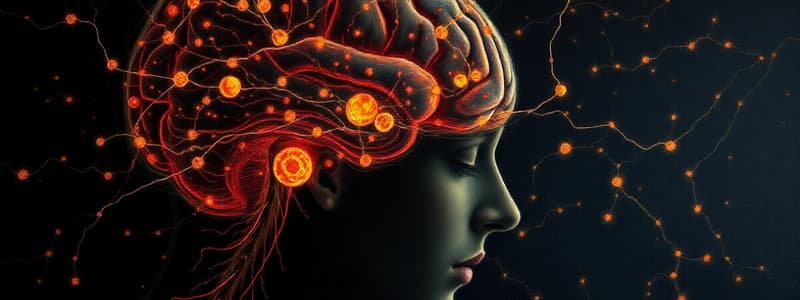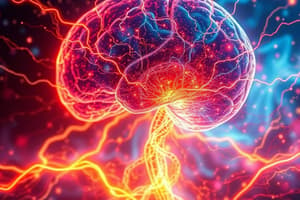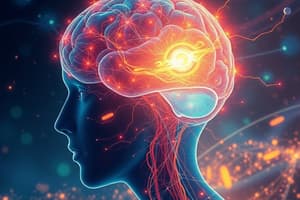Podcast
Questions and Answers
Which of the following risk factors for stroke can be controlled by lifestyle choices?
Which of the following risk factors for stroke can be controlled by lifestyle choices?
- Hypertension (correct)
- Gender
- Genetics
- Age
Which of the following is NOT a sign or symptom of Parkinson's disease?
Which of the following is NOT a sign or symptom of Parkinson's disease?
- Stooped posture
- Mask-like expression
- Rapid movement (correct)
- Tremors
What is the primary function of myelin in the brain and spinal cord?
What is the primary function of myelin in the brain and spinal cord?
- To insulate and protect nerve fibers (correct)
- To produce neurotransmitters
- To provide structural support for nerve cells
- To regulate blood flow to the brain
Which of the following conditions is NOT considered a neurodegenerative disorder?
Which of the following conditions is NOT considered a neurodegenerative disorder?
Which of the following is a common treatment strategy for Parkinson's disease?
Which of the following is a common treatment strategy for Parkinson's disease?
What is the primary cause of death in individuals with Amyotrophic Lateral Sclerosis (ALS)?
What is the primary cause of death in individuals with Amyotrophic Lateral Sclerosis (ALS)?
What is the typical age of onset for Multiple Sclerosis?
What is the typical age of onset for Multiple Sclerosis?
What does FAST stand for in relation to stroke?
What does FAST stand for in relation to stroke?
Which of the following is a potential sign of a stroke?
Which of the following is a potential sign of a stroke?
Which of the following conditions is characterized by the destruction of myelin?
Which of the following conditions is characterized by the destruction of myelin?
Which of the following is a true statement about stroke?
Which of the following is a true statement about stroke?
What is a common complication of Parkinson's disease?
What is a common complication of Parkinson's disease?
Which of the following is a common initial symptom of ALS?
Which of the following is a common initial symptom of ALS?
Which of the following is a characteristic of Huntington's disease?
Which of the following is a characteristic of Huntington's disease?
Which of the following factors increases the risk of stroke?
Which of the following factors increases the risk of stroke?
What is a characteristic change that occurs in the nervous system with aging?
What is a characteristic change that occurs in the nervous system with aging?
Which of the following is NOT a symptom of epilepsy?
Which of the following is NOT a symptom of epilepsy?
What is the main difference between a stroke (CVA) and a Transient Ischemic Attack (TIA)?
What is the main difference between a stroke (CVA) and a Transient Ischemic Attack (TIA)?
How does a stroke affect the brain?
How does a stroke affect the brain?
What are the cognitive functions that can be affected by nervous system disorders?
What are the cognitive functions that can be affected by nervous system disorders?
Which of the following is NOT a physical function that can be affected by nervous system disorders?
Which of the following is NOT a physical function that can be affected by nervous system disorders?
What is the purpose of the video mentioned in the text about epilepsy?
What is the purpose of the video mentioned in the text about epilepsy?
What does the term 'ADLs' refer to in the context of Transient Ischemic Attack (TIA)?
What does the term 'ADLs' refer to in the context of Transient Ischemic Attack (TIA)?
Flashcards
Nervous System Aging
Nervous System Aging
Physical changes include slower nerve conduction and reduced blood flow to the brain.
Effects of Aging on Senses
Effects of Aging on Senses
Age reduces touch, pain sensitivity, and the ability to sense heat and cold.
Cognitive Functions
Cognitive Functions
Cognitive functions include thinking, reasoning, and memory tasks controlled by the mind.
Epilepsy
Epilepsy
Signup and view all the flashcards
Seizure
Seizure
Signup and view all the flashcards
Stroke
Stroke
Signup and view all the flashcards
Transient Ischemic Attack (TIA)
Transient Ischemic Attack (TIA)
Signup and view all the flashcards
Identifying TIA
Identifying TIA
Signup and view all the flashcards
FAST
FAST
Signup and view all the flashcards
Warning signs of stroke
Warning signs of stroke
Signup and view all the flashcards
Risk factors for stroke
Risk factors for stroke
Signup and view all the flashcards
Parkinson’s disease
Parkinson’s disease
Signup and view all the flashcards
Symptoms of Parkinson’s
Symptoms of Parkinson’s
Signup and view all the flashcards
Huntington’s disease
Huntington’s disease
Signup and view all the flashcards
Multiple sclerosis (MS)
Multiple sclerosis (MS)
Signup and view all the flashcards
Symptoms of multiple sclerosis
Symptoms of multiple sclerosis
Signup and view all the flashcards
Amyotrophic lateral sclerosis (ALS)
Amyotrophic lateral sclerosis (ALS)
Signup and view all the flashcards
Symptoms of ALS
Symptoms of ALS
Signup and view all the flashcards
Rehabilitation after stroke
Rehabilitation after stroke
Signup and view all the flashcards
Risk management for stroke
Risk management for stroke
Signup and view all the flashcards
Tremors
Tremors
Signup and view all the flashcards
Cognitive decline
Cognitive decline
Signup and view all the flashcards
Study Notes
Nervous System
- The nervous system experiences physical changes, including nerve cell loss and slowed nerve conduction and reflexes.
- Blood flow to the brain is reduced, altering brain cell function and sleep patterns.
- Sensitivity to touch, pain, pressure, heat, cold, taste and smell are diminished.
Nervous System Disorders
- Nervous system disorders can affect both cognitive and physical functions.
- Physical functions include movement, touch, vision, hearing, bowel and bladder control.
- Cognitive functions include thinking, reasoning, understanding, remembering, learning, reading and problem-solving.
Epilepsy
- Epilepsy involves recurrent episodes of seizures, including convulsive seizures, sensory disturbances, and altered behaviour.
- A seizure is characterised by violent, sudden muscle contractions, tremors, and loss of consciousness.
- A single seizure does not automatically mean a person has epilepsy, but it can be an indicator that epilepsy may develop.
Stroke
- Stroke, also called cerebrovascular accident (CVA), is a disease affecting the arteries that supply blood to the brain.
- A stroke occurs when a blood vessel in the brain is blocked or bursts, disrupting blood flow to a part of the brain.
- A Transient Ischemic Attack (TIA) is a "mini-stroke" and is a temporary blockage causing only brief symptoms, which can quickly subside.
- Stroke is the fourth leading cause of death in Canada, and a common cause of disability in adults.
- Warning signs of stroke (FAST): Face, Arm, Speech, Time.
- Stroke can occur suddenly or with previous warning signs, such as sudden weakness, numbness, tingling, loss of speech, vision problems, severe headache or dizziness.
- Risk factors include age (over 65), gender (men slightly higher risk than women), hypertension, smoking, diabetes, high blood cholesterol, lack of exercise, and high alcohol intake.
- After a stroke, some brain damage is likely, and the extent of lost function depends on the area of brain damage.
- Rehabilitation helps regain lost function to the highest possible level.
Parkinson's Disease
- Parkinson's disease is a slow, progressive disorder affecting the brain's area controlling movement.
- It usually affects those over 50.
- Common symptoms include tremors, rigid muscles (arms, legs, neck, trunk- slow movement), stooped posture, impaired balance, and a mask-like facial expression.
- Symptoms develop gradually over time.
Parkinson's Disease Treatment
- Treatments include medications to control the disease progression and supportive therapies.
- Exercise and physiotherapy can aid in improving strength, posture, balance, and enhance mobility.
- Daily living adjustments (ADLs) may be necessary for the patient.
- Normal elimination is an important factor to consider. Safety measures are needed to prevent falls and injuries.
Huntington's Disease
- Huntington's disease is an inherited neurological disorder that destroys brain cells.
- It causes uncontrolled movements, emotional disturbances, and cognitive losses.
- Symptoms typically emerge between ages 20 and 60.
- Symptoms can include twitching, fidgeting, clumsiness, difficulty eating and swallowing (ADLs).
- There is no cure or treatment.
Multiple Sclerosis
- Multiple sclerosis (MS) is a persistent, slowly progressive disease damaging the myelin sheath covering nerve fibers in the brain and spinal cord; affecting nerve impulse transmission.
- Symptoms typically start between the ages of 15 and 40, and affect women slightly more often than men.
- Symptoms vary greatly among individuals and can include vision problems, muscle weakness, balance problems, tingling, prickling, or numbness, difficulty speaking and swallowing, bladder and bowel issues, pain, extreme fatigue, sensitivity to heat, short-term memory loss or impaired judgement.
- There is no cure, and support needs vary based on the client's requirements and condition.
- Injury prevention and support for bowel and bladder function is essential.
- Clients may require long-term care.
Amyotrophic Lateral Sclerosis (ALS)
- Amyotrophic lateral sclerosis (ALS), also known as Lou Gehrig's disease, is a rapidly progressive, fatal disorder that destroys nerve cells affecting voluntary muscle control.
- It typically manifests between ages 40 and 70.
- Symptoms include difficulty using fingers, difficulty walking, and progressive loss of motor control and function.
- There is no cure.
Spinal Cord Injuries
- Spinal cord injuries disrupt communication between the brain and body, leading to partial or complete paralysis.
- The injury location determines the affected body areas.
- Such injuries are commonly caused by major vehicle accidents (MVAs)
- Rehabilitation is crucial for recovery.
Studying That Suits You
Use AI to generate personalized quizzes and flashcards to suit your learning preferences.




